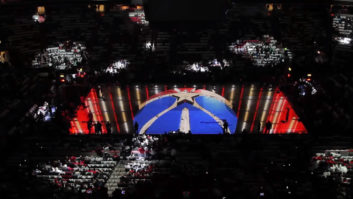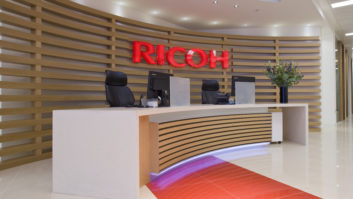
The overwhelming majority of LCD panels produced every year are destined for domestic TV sets. According to IHS Markit, over 226 million TVs will be manufactured in 2019. The cost and complexity of establishing and running a high volume LCD panel manufacturing line means that there are only a handful of major manufacturing companies, all situated in the Far East, that concentrate on the mass production of just a few standard display sizes.
For the professional AV sector this is both a good thing and a bad one. It is good because the sheer number of displays produced and intense competition between the suppliers means that cost of the bare glass panels is low. But bad, because we are at the mercy of the domestic TV market and the sizes and resolutions demanded by TV viewers for their homes – or at least the sizes offered to them.
Fortunately this has not been too much of a problem and the advantages significantly outweigh the disadvantages. Large-scale AV system producers like NEC, LG, Samsung and Sony can produce professional AV displays with dedicated electronic circuitry at a cost that is acceptable to users in this sector: in retail, offices and schools.
It also enables new technologies to be developed, such as OLED and quantum dot. Again these are initially aimed at the domestic user but are finding application, and delivering benefit, to professional AV users. OLED and quantum dot are already being manufactured, albeit in small numbers. IHS forecasts that in 2019 around four million of each will be manufactured and all will carry high price premiums.
The latest generation of displays, using OLED technology, is beginning to become commercially available to the AV sector at prices that are economically viable. “OLED is a technology which is really starting to take off and becoming a standard for creative display design, with architects and designers taking the initiative to use it in increasingly creative ways,” says Nigel Roberts, IT solutions sales head for LG Electronics UK Business Solutions. “We expect OLED to be at the forefront of the LG product portfolio in the coming years. It has already revolutionised the way in which brands now communicate to shoppers in retail environments and out-of-home advertising, with companies opting for more creative formations to capture the attention of buyers. As viewers expect more dynamic installations, we’ll begin to see technology incorporated into the design process at an earlier stage.
“LG has a number of innovations in the pipeline which will result in the introduction of new creative forms and new technology types. Next year transparent OLED displays will become available. In digital signage applications it will enable sharp content to be displayed on a 40% transparent screen and marks a dynamic step forward for retail displays. Merging product and content like this will enhance the mixed media experience”
OLED is not without its problems though. There is widespread understanding in the AV industry that this technology is not suited to commercial digital signage or presentation applications. The image retention of OLED in large sized displays remains high and creates serious problems when showing static content over longer periods. Many integrators can still remember the problems that image retention caused in plasma displays and, to a slightly lesser extent, in the early days of LCD on screens that continuously cycled between a few static screens. The display would build up an underlying permanent image that could only be removed by application of blank or inverse images over an extended time period – hardly conducive to good digital signage.
8K viability
Display resolutions are increasing too. IHS Markit reports that over half of TV shipments next year will be 4K UHD. Next generation 8K TVs will start to penetrate the market in substantial numbers soon: they estimate that the global quantity shipped will grow from less than 20,000 in 2018 to more than 430,000 in 2019. These, too, will be available to the pro AV market although there is some question about how soon this is likely. “Today, 4K UHD appears to be the resolution of the immediate future. Already the majority of larger size LCD displays have moved to 4K UHD where the increased resolution has greatest effect,” explains Thomas Walter, section manager strategic product marketing, NEC Display Solutions Europe. “However, most smaller-sized displays, including projectors, desktop monitors and direct view LED screens are still only on their way to 4K UHD.
However an issue that Robert Bartelds, senior product manager at Philips Professional TV foresees is that content needs to be available for high resolution playout: “New formats require the content industry to invest in replacing their infrastructure, which they are currently undertaking with 4K. This makes it unlikely that they will repeat this for 8K for quite some time. Non-standard resolutions exist in professional displays but this limits their appeal.” We currently lack the bandwidth and content for 8K displays and it is likely to be at least five years until 8K displays become the preferred choice.
Display size is increasing. “Large size LCD displays with reader-friendly UHD resolution and sizes up to 100in are subject to greater demand in the market,” says Walter. “Even though it is not a brand new technology, it will be new for many end users and represents the biggest business potential today. Large LCD-based displays are mainly used for smaller and mid-sized meeting rooms, for interactive boards in education, corporate environments and for digital signage applications with high impact.”
Corporate innovation
LCD displays are attractive to the retail and commercial sectors, with retail traditionally absorbing a larger percentage of supply. This does appear to be changing, for reasons Roberts explains: “The corporate sector is starting to really drive the market with innovation, where retail used to always be the first innovators. They are used in situations in which creativity is at the forefront of activities such as collaboration and huddle spaces. In fact, collaborative working areas are emerging as a new market vertical. Office atriums and inspiration labs have also been popular areas for new screens in recent months.”
The shift in work patterns and structure has undoubtedly affected take up of screens in the corporate environment, particularly large interactive touch panels. This affects not just the size and style of the screens offered, but their internal capabilities and features. “An increasing number of end users are working collaboratively in meeting rooms, connecting personal devices and sharing multiple content streams from multiple devices,” comments Chris McIntyre-Brown, associate director at Futuresource Consulting. “This has resulted in a number of display manufacturers increasingly embedding wireless technologies in their solutions or launching peripheral devices offering this functionality. There has also been a recent increase in the launch of end-to-end interactive solutions from ecosystem players, namely Microsoft, Google and Cisco, that is redefining how a display solution is both perceived and utilised. All of which provides further insight and vision for the changing needs and opportunities in this space.”
www.futuresource-consulting.com
www.lg.com
www.nec-display-solutions.com
www.philips.co.uk/p-m-pr/professionaldisplays







